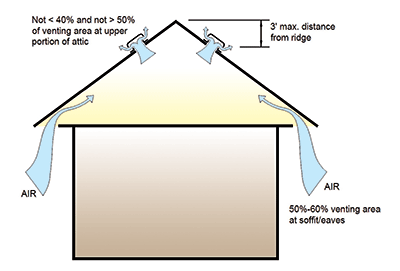These fans are usually wired to run in one direction.
Attic fan air flow direction.
However if your attic has blocked soffit vents and is not well sealed from the rest of the house attic fans will suck cool conditioned air up out of the house and into the attic.
A fan set to move clockwise opposite the ceiling fan direction in summer and run on low speed creates an updraft.
This pulls cool air up toward the ceiling which in turn displaces the warm air that rises and collects near the ceiling.
Ceiling fan direction in the winter should be clockwise and the fan should run at the lowest speed.
A ceiling fan that spins clockwise will draw cooler air up and force warmer air near the ceiling down and out toward walls.
This position is also known as the reverse direction because warm air rises the air near the ceiling can be three to four degrees warmer than air near the floor.
Attic fan ventilation attic fans are intended to cool hot attics by drawing in cooler outside air from attic vents soffit and gable and pushing hot air to the outside.
After entering the soffit air needs to flow upward and exit through gable vents or ridge vents cooling the roof structure and roof covering to outdoor temperature.
Powered attic ventilator fansdesigned to cool your attic by drawing the hot and humid air out of the attic and bring in a flow of chilly air from outside.
Again terminology gable vents are vents that are installed on the ends of the roof rise and ridge vents are installed at the peak of the roof.
You place the fans on the gable walls of your attic.
Intake vents located at the lowest part of the roof under the eaves allow cool.
Attic ventilation works on the principle that heated air naturally rises primarily utilizing two types of vents.
That pulls cold air up to the ceiling and more evenly distributes the warmth the.

